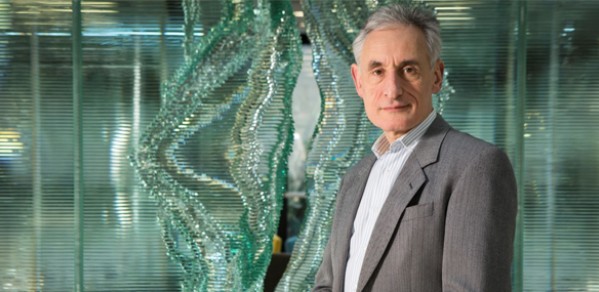
Cambridge Engineering alumnus and Microsoft Research Cambridge Laboratory Director, Professor Andrew Blake, gave the prestigious American Mathematical Society Gibbs Lecture.
Mathematical thinking is making the world safer, healthier, and much more interesting, by means of machines that can see.
Alumnus Professor Andrew Blake
Eighty years ago, Albert Einstein was invited to deliver the 11th instalment of the Josiah Willard Gibbs Lecture, established by the American Mathematical Society (AMS) in 1923 to give the public insight into the intricacies of mathematics and its applications. Subsequent Gibbs Lecturers in engineering and computer science have included Vannevar Bush, John von Neumann, Donald Knuth, and Herbert Simon.
Now, during the 2014 Joint Mathematics Meetings, billed as the largest mathematics meeting in the world, the latest edition of the Josiah Willard Gibbs Lecture was delivered by Andrew Blake, Microsoft distinguished scientist and laboratory director of Microsoft Research Cambridge.
Needless to say, Blake was delighted and humbled to join such illustrious company.
“When I was first invited and looked at the list of previous lecturers, I was pretty much dumbstruck,” says Blake, whose presentation, Machines That See, Powered by Probability, was delivered in the Baltimore Convention Center. “It contains many of the best-known names in mathematics, physics, and other sciences.
“I am the sixth British scientist to be invited, the first being one of my heroes of undergraduate days, the mathematician G.H. Hardy, whose explanation of real numbers is so beautiful as to bring tears to the eyes. I am blown away by the sheer weight of tradition and very excited to be representing the field of computer vision and explaining how mathematics has helped lead to machines that can see.”
Gibbs, a mathematical physicist who died in 1903, ranks as one of the greatest scientists in American history, and the lectureship named in his memory is one of the highlights of the Joint Mathematics Meetings, which this year comprised both the 120th annual meeting of the AMS and the 97th annual winter meeting of the Mathematical Association of America.
The goal of the Gibbs Lecture is to enable the public and the academic community to gain awareness of the contribution that mathematics is making to present-day thinking and modern civilisation. Blake’s contributions make him eminently worthy of carrying such a weighty responsibility.
He joined Microsoft Research in 1999 after 18 years in academia. While on the faculty of the University of Oxford, he was a pioneer in the development of theory and algorithms that enable computers to behave as seeing machines. Once at Microsoft Research Cambridge, he founded the Computer Vision group and then served as deputy managing director before assuming his current role in 2010.
Along the way, he has received recognition for his achievements, including:
- Twice winning the prize of the European Conference on Computer Vision.
- The IEEE David Marr Prize in 2001.
- The Royal Academy of Engineering Silver Medal in 2006.
- The Institution of Engineering and Technology Mountbatten Medal in 2007.
- Being elected to the council of the Royal Society in 2010.
- Receiving the MacRobert Award from the Royal Academy of Engineering in 2011, along with colleagues from Microsoft Research Cambridge, for machine-learning contributions to Kinect.
In addition, Blake has been named a Fellow of the Royal Academy of Engineering and the Royal Society, and he has been presented with honorary degrees from both the University of Edinburgh and the University of Sheffield.
“For humans,” he explains, “seeing is effortless, something that happens largely subconsciously, using the parallel computational power amassed inside our skulls. It is so effortless that the first challenge in realising artificial vision is to appreciate just how hard the problem is.
“The pioneers of the 1960s, in the glory days of artificial intelligence, thought that the problem would be largely solved after one decent summer of effort. In the event, 50 years later, some progress has been achieved, but there is still much to do to reach anything approaching human visual capability.”
Blake’s Gibbs Lecture focused on the principles of representing shape and tracking changes of shape over time, highlighting the importance of probability and machine learning.
“Modern artificial-vision systems,” he says, “are a complex amalgam of software for signal processing, computational geometry, optimization, and machine learning.
“The visible world is awash with ambiguity, and probability, the calculus of uncertainty, is an important element of the computer systems that resolve that ambiguity.”
Much, Blake says, already has been achieved, and substantially this is thanks to mathematical—geometric and probabilistic—principles.
“These days, we have machines with vision working on a commercial scale,” he observes. “There are smart cars, smart cameras that compose shots automatically and stitch panoramas, medical-imaging machines that analyse their own data and help with diagnosis, and three-dimensional cameras that track the movement of the human body.
“Mathematical thinking is making the world safer, healthier, and much more interesting, by means of machines that can see.”

